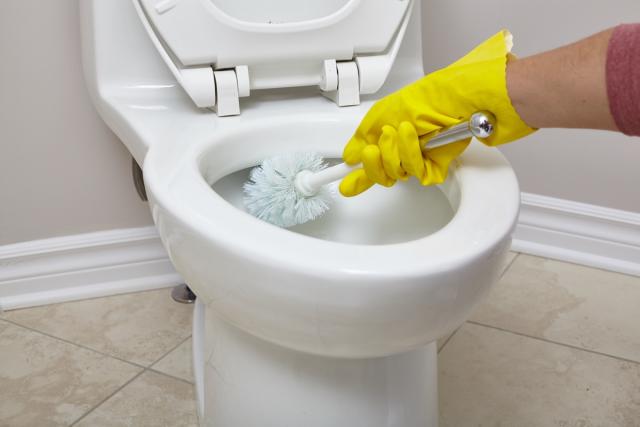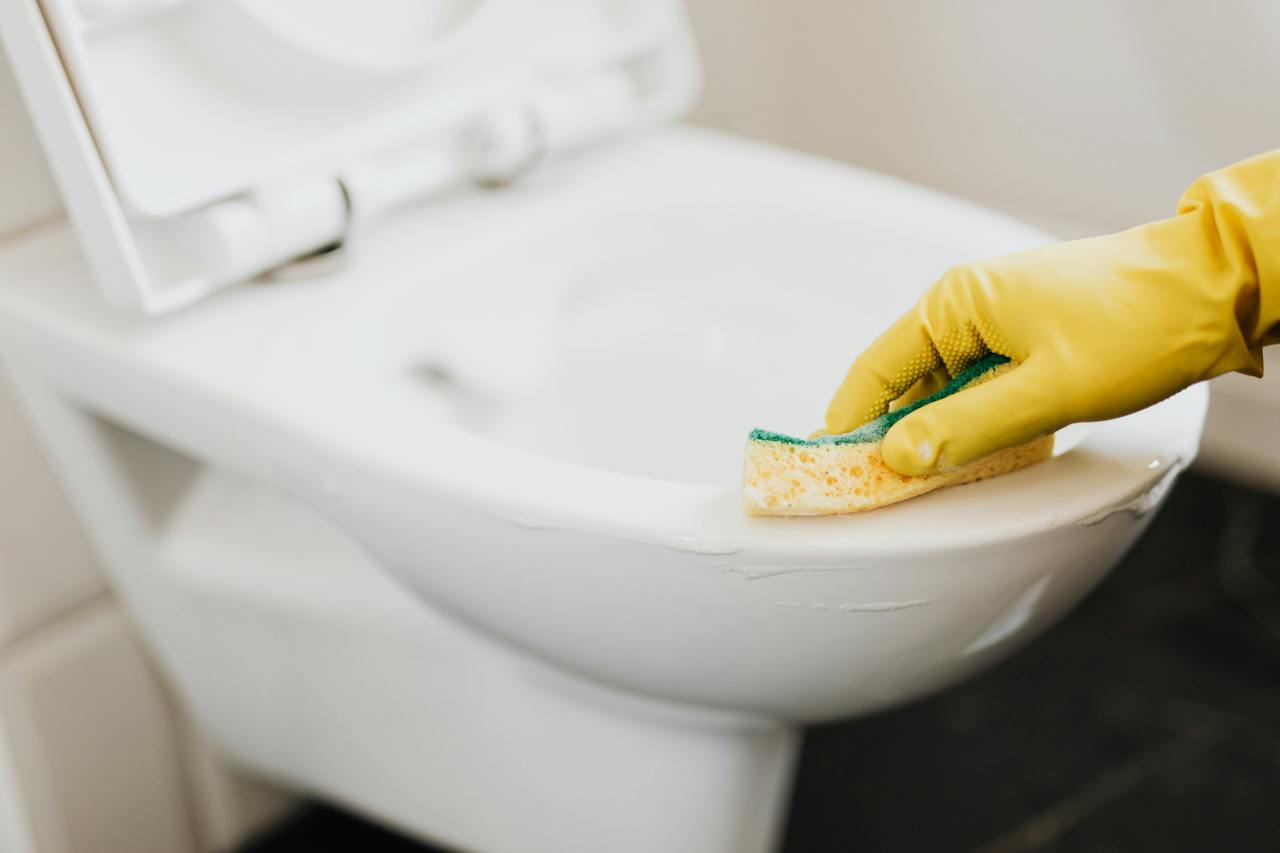
Why Does Mold Grow in Toilets?
Toilets provide the perfect environment for mold growth due to the constant presence of water and moisture. Mold spores thrive in damp, dark areas, and toilets — especially those not used often — can become a breeding ground for mold. Additionally, mineral deposits in the water or organic matter can contribute to the growth of mold, particularly around the bowl and under the rim.
Common reasons for mold growth in toilets include:
- Standing water: Mold thrives in stagnant water, making toilets with poor flushing mechanisms or those left unused for long periods susceptible to mold buildup.
- High humidity: Bathrooms with high humidity levels are more likely to develop mold, especially in areas that are not properly ventilated.
- Lack of cleaning: Mold can form in toilets if they are not regularly cleaned, particularly in hidden areas like under the rim where mold spores can accumulate.
For more insights on how mold develops in bathrooms and other damp environments, check out this guide by the EPA.

How to Remove Mold from Your Toilet: Step-by-Step Guide
Getting rid of mold in your toilet may seem daunting, but with the right cleaning methods, it can be done safely and effectively. Follow these steps to eliminate mold and restore your toilet to a clean, mold-free state:
| Step | How to Do It |
|---|---|
| 1. Wear Protective Gear | Mold can cause allergic reactions and respiratory issues, so it’s important to wear protective gloves and a mask while cleaning. This will protect you from mold spores that may become airborne during the cleaning process. |
| 2. Use White Vinegar | White vinegar is a natural mold killer and an effective cleaning solution for toilets. Pour one cup of white vinegar into the toilet bowl, making sure to cover the moldy areas. Let it sit for 30 minutes to break down the mold before scrubbing. |
| 3. Scrub with a Toilet Brush | After letting the vinegar sit, use a toilet brush to scrub the bowl thoroughly. Pay extra attention to the areas under the rim, as mold often grows in these hidden spots. For stubborn stains, use a pumice stone to gently scrub the mold without damaging the porcelain. |
| 4. Flush and Repeat | After scrubbing, flush the toilet to remove the mold and vinegar. If any mold remains, repeat the process until the toilet is clean and free of mold stains. For extra cleaning power, you can add baking soda to the bowl along with the vinegar. |
| 5. Clean the Tank | Mold can also grow in the toilet tank, leading to recurring mold issues in the bowl. Pour a cup of white vinegar into the tank, let it sit for 30 minutes, and then scrub the inside of the tank with a brush. Flush the toilet to rinse out the tank. |
| 6. Disinfect with Bleach | If the mold is particularly stubborn, you can use bleach to disinfect the toilet. Pour half a cup of bleach into the toilet bowl and scrub thoroughly. Be sure to use bleach sparingly, as it can be harsh on your plumbing system and the environment. For more eco-friendly alternatives, see Good Housekeeping’s cleaning guide. |
If the mold in your toilet persists or if you notice mold spreading to other areas of your bathroom, it may be time to call in the professionals like Citywide Mold Mitigation for a thorough mold inspection and remediation.
Natural Solutions for Removing Mold from Toilets

If you prefer natural cleaning solutions, there are several eco-friendly options that can effectively remove mold from your toilet without the need for harsh chemicals. Here are a few natural alternatives:
1. White Vinegar and Baking Soda
As mentioned earlier, white vinegar is an excellent natural mold killer. For added cleaning power, mix white vinegar with baking soda to create a fizzy reaction that helps break down mold and stains. Sprinkle baking soda into the toilet bowl and pour vinegar over it. Let the mixture sit for a few minutes before scrubbing with a toilet brush.
2. Tea Tree Oil
Tea tree oil is known for its antifungal properties, making it a great natural solution for removing mold. Add 10-15 drops of tea tree oil to a spray bottle filled with water and spray it onto the moldy areas of the toilet. Let it sit for 10-15 minutes before scrubbing with a brush.
3. Lemon Juice
Lemon juice is a natural disinfectant and can help remove mold stains while leaving your bathroom smelling fresh. Apply lemon juice directly to the moldy areas and scrub with a brush. This method works particularly well for lighter mold stains and regular maintenance.
How to Prevent Mold from Growing in Your Toilet

Once you’ve removed mold from your toilet, it’s important to take steps to prevent it from returning. Here are some effective ways to keep mold out of your bathroom:
1. Flush Toilets Regularly
Mold often forms in toilets that aren’t used or flushed regularly, as stagnant water provides the perfect environment for mold growth. Be sure to flush toilets at least once a day, especially in bathrooms that don’t see regular use.
2. Lower Bathroom Humidity
High humidity is one of the biggest factors contributing to mold growth in bathrooms. Use an exhaust fan or open windows after showers to improve ventilation and reduce humidity levels. You can also place a dehumidifier in the bathroom to keep moisture levels under control. Learn more about controlling bathroom humidity at HGTV’s dehumidifier tips.
3. Clean Toilets Weekly
Regular cleaning is key to preventing mold from growing in your toilet. Clean the toilet bowl and under the rim at least once a week using a disinfectant or a natural cleaner like vinegar. Don’t forget to clean the toilet tank as well, as mold can grow inside the tank and spread to the bowl.
4. Use Vinegar as a Preventative Solution
To keep mold at bay, pour a cup of white vinegar into your toilet bowl once a week and let it sit for 30 minutes before scrubbing and flushing. This simple routine will help prevent mold from forming and keep your toilet smelling fresh.
When to Call Citywide Mold Mitigation for Help
If you’ve tried these cleaning methods and the mold in your toilet keeps returning, or if you notice mold spreading to other areas of your bathroom or home, it may be time to call in a professional. Mold can spread quickly and lead to more serious health and structural issues if not addressed properly.
Citywide Mold Mitigation specializes in mold removal and prevention services. Our experts can assess the extent of the mold problem in your home, safely remove it, and provide solutions to prevent future growth. Contact us today for a free consultation and take the first step toward a mold-free home.
FAQ
| Question | Answer |
|---|---|
| Why does mold keep growing in my toilet? | Mold grows in toilets due to the constant presence of moisture. Toilets that aren’t flushed regularly, have standing water, or are located in high-humidity areas are particularly prone to mold growth. |
| Is mold in toilets dangerous? | While small amounts of mold in toilets may not pose an immediate health risk, exposure to mold can cause allergic reactions and respiratory issues over time. It’s important to clean and remove mold promptly to maintain a healthy home. |
| What’s the best cleaner for mold in toilets? | White vinegar and baking soda are effective natural cleaners for removing mold from toilets. For stubborn mold stains, you can also use a disinfectant cleaner or a small amount of bleach. |
| How do I keep mold from coming back? | To prevent mold from returning, flush your toilet regularly, reduce humidity levels in the bathroom, and clean your toilet weekly. Using white vinegar as a preventative measure can also help stop mold from forming. |
| When should I call a professional for mold remediation? | If mold continues to grow despite regular cleaning or if it spreads to other areas of your home, it’s best to call a professional mold remediation service like Citywide Mold Mitigation for expert assistance. |
If you’re dealing with persistent mold in your toilet or bathroom, reach out to Citywide Mold Mitigation today for professional mold remediation and prevention services.

